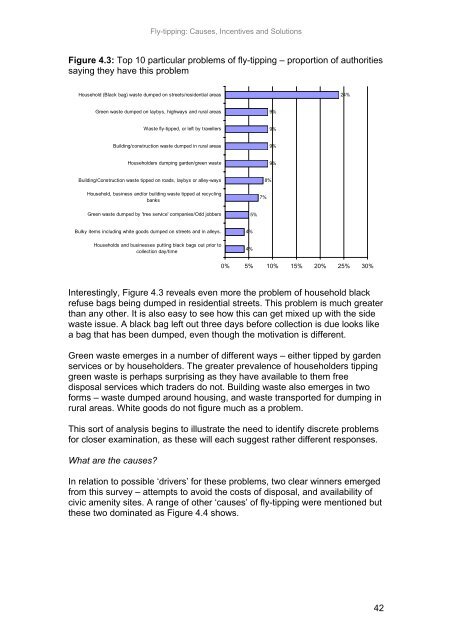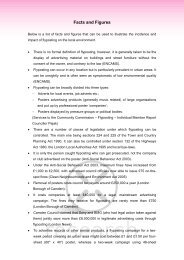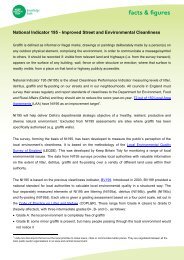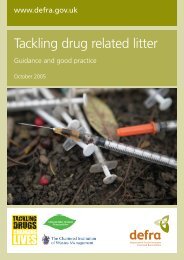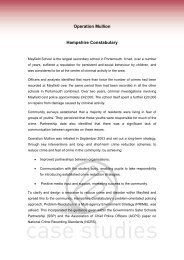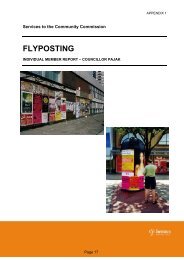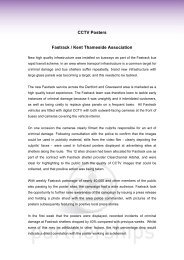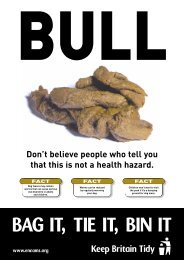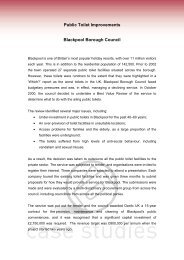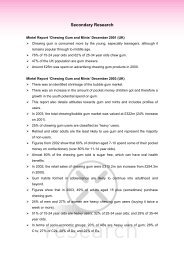Fly-tipping: Causes, Incentives and Solutions - Keep Britain Tidy
Fly-tipping: Causes, Incentives and Solutions - Keep Britain Tidy
Fly-tipping: Causes, Incentives and Solutions - Keep Britain Tidy
Create successful ePaper yourself
Turn your PDF publications into a flip-book with our unique Google optimized e-Paper software.
<strong>Fly</strong>-<strong>tipping</strong>: <strong>Causes</strong>, <strong>Incentives</strong> <strong>and</strong> <strong>Solutions</strong><br />
Figure 4.3: Top 10 particular problems of fly-<strong>tipping</strong> – proportion of authorities<br />
saying they have this problem<br />
Household (Black bag) waste dumped on streets/residential areas<br />
24%<br />
Green waste dumped on laybys, highways <strong>and</strong> rural areas<br />
9%<br />
Waste fly-tipped, or left by travellers<br />
9%<br />
Building/construction waste dumped in rural areas<br />
9%<br />
Householders dumping garden/green waste<br />
9%<br />
Building/Construction waste tipped on roads, laybys or alley-ways<br />
Household, business <strong>and</strong>/or building waste tipped at recycling<br />
banks<br />
7%<br />
8%<br />
Green waste dumped by 'tree service' companies/Odd jobbers<br />
5%<br />
Bulky items including white goods dumped on streets <strong>and</strong> in alleys.<br />
Households <strong>and</strong> businesses putting black bags out prior to<br />
collection day/time<br />
4%<br />
4%<br />
0% 5% 10% 15% 20% 25% 30%<br />
Interestingly, Figure 4.3 reveals even more the problem of household black<br />
refuse bags being dumped in residential streets. This problem is much greater<br />
than any other. It is also easy to see how this can get mixed up with the side<br />
waste issue. A black bag left out three days before collection is due looks like<br />
a bag that has been dumped, even though the motivation is different.<br />
Green waste emerges in a number of different ways – either tipped by garden<br />
services or by householders. The greater prevalence of householders <strong>tipping</strong><br />
green waste is perhaps surprising as they have available to them free<br />
disposal services which traders do not. Building waste also emerges in two<br />
forms – waste dumped around housing, <strong>and</strong> waste transported for dumping in<br />
rural areas. White goods do not figure much as a problem.<br />
This sort of analysis begins to illustrate the need to identify discrete problems<br />
for closer examination, as these will each suggest rather different responses.<br />
What are the causes?<br />
In relation to possible ‘drivers’ for these problems, two clear winners emerged<br />
from this survey – attempts to avoid the costs of disposal, <strong>and</strong> availability of<br />
civic amenity sites. A range of other ‘causes’ of fly-<strong>tipping</strong> were mentioned but<br />
these two dominated as Figure 4.4 shows.<br />
42


